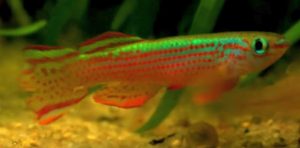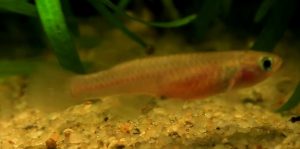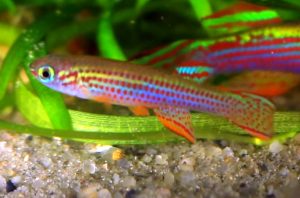The Red Striped Killifish (Aphyosemion striatum) is found locally between the lower Mitmele River, in Equatorial Guinea and the lower Ogooué basin in Gabon, including the Mbei, Komo,and Gabon watersheds in western Africa, and is regarded as a good “beginners Killie” by many tropical fish keeping enthusiasts.
The Red Striped Killifish inhabits the freshwater swamps and slow moving coastal lowland rain forest streams and pools in its range, and prefers soft, slightly acidic, dimly lit, water in highly vegetated areas.
The Red Striped Killifish is an an attractive non annual species that is relatively long lived. They have a pike like body shape with an upturned mouth and a dorsal fin that is set back toward the caudal fin, and slightly to the rear of the ventral fin.
The Red Striped Killifish is named for the vibrant red stripes that run laterally along the body flanks of the males. They also exhibit red spots on the central portion of the caudal fin, and red/blue banding or edging on the dorsal and anal fins.
Adult males are larger, more intensely colored, and have longer caudal, dorsal, and anal fins than females.
Females are typically a dull brownish/creme color, have clear colorless fins, and are slightly smaller than the males. Some variants do have black edging on their dorsal fins.
Aphyosemion striatum are best housed in a densely planted bio tope tank of at least 10 gallon capacity, with a dark sand or fine gravel substrate, a small piece of driftwood or two, some floating plants to diffuse the lighting an minimize jumping, and some dried Indian Almond leaves or peat moss on the bottom if you intend to breed the fish. They do well in lower water temperatures and at room temperatures do not require a heater.
Red Striped Killifish are a peaceful species and are suitable for a community tank environment. They can be housed with other small peaceful species of Dwarf Cichlids, Rasboras, Coradoras, Tetras, small Loricariids, etc. but need a tightly fitting tank cover to prevent them from jumping from the aquarium.
Aphyosemion striatum are very easy to breed in an aquarium environment. Although most breeders do not use any filtration in the breeding tank, a small air driven sponge filter is recommended to prevent stagnation.
Select, separate, and condition your breeding stock on a diet of live or frozen foods for a week or so, and place either a conditioned male and two or three females, or a single pair into a small, unlit breeding tank with neutral to slightly acidic water at a temperature of 68 to 78 degrees F. Use spawning mops, clumps of fine leaved plants like Taxiphylum, or a layer of peat moss on the floor of the aquarium as the spawning medium.
The fish will deposit their eggs in batches of 10 to 30 on the spawning medium daily for about two weeks, but it’s better to remove the fish after the first week. Remove the eggs daily to a rearing tank or place them on a layer of damp peat moss in a small container. Remove any infertile or white fungus coated eggs immediately to prevent the spread of the disease.
If you are incubating the eggs in water, transfer them into a small, covered aquarium filled with about 2 inches of soft, acidic water with a pH between 6.0 and 6.5, the temperature between 68 and 72 degrees F with 2 or 3 drops of Methylene Blue added. Keep the tank in total darkness for 10 to 14 days, at which time hatching should commence.
When incubating the eggs in peat moss, keep the container in a dark, warm location and leave it undisturbed for about 18 days. Placing the eggs back into the tank water is all that is needed to induce hatching. If they do not hatch when placed back into the tank, blow some air gently into the water through some airline tubing to slightly oxygenate the eggs or put them into a closed container in your pocket and walk around with them for an hour or so.
Aphyosemion striatum fry are tiny and initially need to be fed infusoria, green water, or liquifry. After a couple of days the fry will be on the surface hunting for food and able to eat Vinegar worms
, microworms
, newly hatched brine shrimp, etc.
During the grow out period, the fry should be fed twice a day with small water changes every couple of days to maintain water quality and promote growth. The fry are extremely susceptible to Velvet Disease (Piscinoodinium parasites) during this period.
As the fry grow larger, the water level in the rearing tank can be raised back to its normal level.
In the wild, Red Striped Killifish feed on aquatic and terrestrial invertebrates. In an aquarium environment they should be fed small live, frozen, and freeze dried Daphnia, bloodworms
, blackworms, brine shrimp, and tubifex. In most cases they will also accept a good quality omnivore flake food.
Red Striped Killifish (Aphyosemion striatum) are relatively common and are available from specialty tropical fish shops and online from a variety of sources at moderate prices.
Minimum Tank Size: 10 gallons
Care Level: Moderate
Temperament: Peaceful, Shy
Aquarium Hardiness: Hardy
Water Conditions: 68-73° F, 5-12°dGH, pH 6.5-7.5
Max. Size: 2”
Color Form: Gold, Brown, Orange
Diet: Carnivore
Compatibility: Biotope and Commuinity tanks
Origin: West Africa
Family: Nothobranchiidae
Lifespan: 3-5 years
Aquarist Experience Level: Experienced




